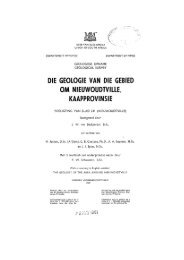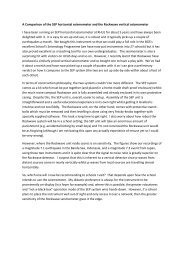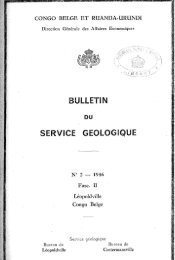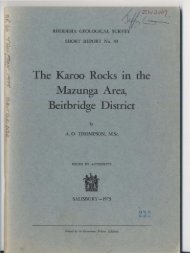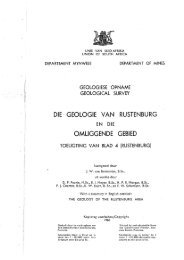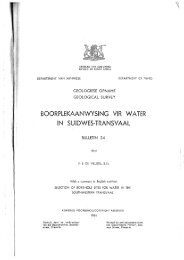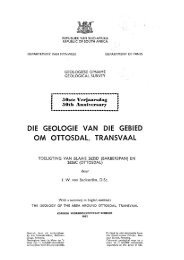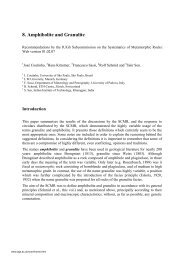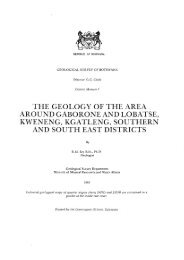Bibliography - British Geological Survey
Bibliography - British Geological Survey
Bibliography - British Geological Survey
Create successful ePaper yourself
Turn your PDF publications into a flip-book with our unique Google optimized e-Paper software.
and rowing would be minimal, and its length: beam ration does not suggest manoeuvrability.’ It’s<br />
authenticity, as realised by Dawson, is thus doubtful. See also Russell 2003, 55–60)<br />
Dawson, C. 1896. Note on the seals of the barons and of the bailiffs of Hastings. Sussex Archaeological<br />
Collections, 40, 261–264, 2 plates. (Read at the Society’s visit to Hastings, 10 Oct 1894. Photos of seals<br />
are credited to Dawson, who was clearly a very capable photographer.)<br />
Dawson, C. 1897. Discovery of a large supply of “natural gas” at Waldron, Sussex. Nature, 57 (16 Dec),<br />
150–151. (Preliminary report on a discovery of gas which occurred accidentally while boring for water in<br />
the parish of Waldron, Sussex. Dawson reports that ‘I have taken samples of the gas, and submitted it to the<br />
county analyst for East Sussex (Mr. S. A. Woodhead), and he informs me, although he has not yet completed<br />
his analysis, that the gas is probably derived from petroleum... I am making experiments with the gas, and<br />
examining the cores of the boring with a view to ascertain the source of the supply.’ See Dawson 1898c)<br />
Dawson, C. 1898a. List of Wealden and Purbeck-Wealden fossils. Abstracts of Papers, Brighton and Hove<br />
Natural History and Philosophical Society, for year ending June 1898, 31–37; also issued separately.<br />
Dawson, C. 1898b. Ancient and modern “dene holes” and their makers. <strong>Geological</strong> Magazine, dec. 4, 5 (7),<br />
293‒302, plate XI; also Report and Transactions of the South-Eastern Union of Scientific Societies, third<br />
annual congress, Croydon, June 1898, 34–46 (with discuss). (Some of Dawson’s conclusions, put forward<br />
as new, appear to have been lifted without acknowledgement from an earlier report on deneholes by the<br />
Essex Field Club. See Russell 2003, 108–111)<br />
Dawson, C. 1898c. On the discovery of natural gas in East Sussex. Quarterly Journal of the <strong>Geological</strong><br />
Society of London, 54 (3) Aug, 564‒571. (This paper was followed by a note from J. T. Hewitt, pp. 572‒573,<br />
who had made an independent analysis of the gas and come to a conclusion regarding the suitability of the<br />
gas for illumination which differed markedly from that of Dawson. In the discussion that followed the reading<br />
of these two papers, pp. 573‒574, Hewitt insisted that the gas came from a layer of compressed vegetation<br />
and not, as stated by Dawson, from a deeper petroleum-bearing horizon. Hewitt was subsequently proven<br />
wrong, and Costello (1986) has argued that he harboured some resentment at having been ‘set right by a<br />
mere amateur dabbler, especially in the cocky manner of Charles Dawson.’ Hewitt thus becomes another<br />
candidate for Piltdown ‘hoaxer’.)<br />
Dawson, C. 1901a. Discovery of a mummified toad in a flint nodule found at Lewes, Sussex. Abstracts of<br />
Papers, Brighton and Sussex Natural History and Philosophical Society, for year ended June 1901, 34–39;<br />
also exhibited at the Linnean Society on 18 April 1901 and figured in the Illustrated London News and<br />
Graphic. (See Cooper, J. 1993; Russell 2003, 126–128)<br />
Dawson, C. 1901b. The services of the barons of the Cinque Ports at the coronation of the kings and queens<br />
of England, and the presidency of Hastings Port. Sussex Archaeological Collections, 44, 45–54, 2 plates.<br />
Dawson, C. 1902. Note on the Hastings Corporation relics of coronations of the kings and queens of<br />
England. Sussex Archaeological Collections, 45, 110–113.<br />
Dawson, C. 1903. Sussex iron work and pottery. Sussex Archaeological Collections, 46, 1–62, 28 plates.<br />
(Including description of a cast iron statuette claimed by Dawson to be ‘the earliest known example of castiron,<br />
in Europe at least’, pp. 4–5 & plate 1, fig. 1. See C. H. Read 1893. This is now known to be of 19th<br />
century date. It is clear that large sections of text were lifted and cleverly reassembled from a <strong>Geological</strong><br />
<strong>Survey</strong> memoir on The Geology of the Weald (1875) by W. Topley. Dawson also described a ‘transitional’<br />
horseshoe, being a cross between the Roman ‘hippo-sandal’ and a modern horseshoe, pp. 23–24 & plate 6,<br />
fig. 10. See Russell 2003. Concerning the ‘Sussex Martyrs’ fireback illustrated in plate 8e, see Paine 2013.)<br />
Dawson, C. 1903. Sussex pottery: a new classification. Antiquary, 39, 47–49.<br />
Dawson, C. 1905. Old Sussex glass: its origin and decline. Antiquary, 41 (Jan), 8–11.<br />
Dawson, C. 1907. Some inscribed bricks and tiles from the Roman Castra at Pevensey (Anderida?), Sussex.<br />
Proceedings of the Society of Antiquaries of London, ser. 2, 21, 410–413 (with discuss). (On11 April 1907,<br />
Dawson presented before the Society at least three stamped bricks from the Roman fort at Pevensey bearing<br />
the only known epigraphic evidence of the Emperor Honorius in England. Dawson claimed to have found<br />
two of them himself in 1902, while a third incomplete example had been discovered during excavations<br />
made under the direction of the Sussex Archaeological Society in 1906–07 (Salzmann 1908). These brickstamps<br />
are now known to be modern forgeries: see Peacock 1973.)



